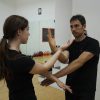It is said that over 300 years ago, during the siege of Shaolin monastery by Manchu soldiers, broke out a fire that completely destroyed the monastery and killed most of its abitanti. Only few people managed to escape and later lived under an alias in other places. These survivors belonged Ng Mui, one of the so-called five elders of the monastery Shaolin. The Buddhist nun moved on a mountain bordering with the province of Szechwan in China.
To take revenge on the traitors who had caused the disaster of the Shaolin monastery, Ng Mui believed that was necessary to create a new method of fighting that was superior to the Shaolin Kung-Fu. This new system should have exploited in their favor all the weak points of Shaolin Kung-Fu. Once succeeded in its intent, Ng Mui passed his knowledge to a girl named Yim Wing Tsun. The result was a totally new combat system: the Wing Tsun (WT).
That things went more or less like this, one thing is certain: the WT system was developed to overcome the techniques of Shaolin Kung-Fu. It is, therefore, in total contradiction to the traditional theories of most Asian martial arts that have their origin (eg .: Karate or Tae Kwon Do) from Shaolin Kung-Fu.
By some of Ip Man manuscripts:
The founder of the Wing Tsun system, the then young girl Yim Wing Tsun, was Cantonese origins (Chinese province of Kwangtung). She was a young, athletic girl, a straight and honest in manners and in words. Her mother died soon after her betrothal to Leung Bok Chau, a salt merchant of Fukien. Her father, Yim Yee, was wrongfully accused of a crime and, rather than risk jail, he decided to escape taking with him his daughter.
The two found refuge at the foot of Tai Leung mountain, near the border between the provinces of Yuan and Szechuan. Here made their living by sending out a shop that sold bean curd.
During the reign Kangshi of the Ching Dynasty (1662-1722) Kung-Fu of the Siu Lam Monastery (Shaolin) on Mt. Sung, Honan Province, it became stronger and stronger.
This aroused the fear of the Manchu government [a non-Chinese population from northern Manchuria, which at that time dominated China], which sent troops to attack the monastery. Since they were unsuccessful, a man named Chan Man Wai, a recently appointed civil servant who sought favors from the government, suggested a plan.
He plotted together to monk Ma Ning Yee and others who were persuaded to betray their companions, to set fire to the monastery from the inside when this was being besieged by soldiers from the outside. Siu Lam (Shaolin) was burned down, and the monks and disciples scattered. Buddhist Abbess Ng Mui, the abbots Chi Shin and Pak Mei Fung To Tak and Master Miu Hin escaped and went their own way.
Ng Mui took refuge in White Crane Temple on Mt. Tai Leung [also known by the name of Mt. Chai Har]. And it was in that place that he met Yim Yee and his daughter Wing Tsun, by whom he was often bought bean curd on her way home from the market. At fifteen, with her hair done up in the style that was used in those days to show that a girl was marriageable age, the beauty of wing tsun attracted the attention of a local bully. He tried to force Wing Tsun to marry him, and his continuous threats started to become a source of worry to her and her father. Ng Mui learned of this and took pity on comparisons of wing tsun, he decided to teach her fighting techniques so that she could protect herself. Wing Tsun followed Ng Mui into the mountains and began to learn Kung Fu. He practiced day and night until he became master of these techniques.
In the end she challenged the fight and beat him.
Ng Mui in continued shifted from that mountain and traveled to China, but before she left she told Wing Tsun to honor the traditions of Kung Fu, to continue and develop her technique after marriage and to help the people working to overthrow the Manchu government and restore the Ming dynasty.
After the marriage Wing Tsun taught Kung Fu to her husband Leung Bok Chau. He passed on these techniques to Leung Lan Kwai that passed on to Wong Wah Bo
Wong Wah Bo was a member of a company of actors who moved on the rivers with reed boats and traveled with him Leung Yee Tei. These came from the Red Giunco company where he met the Abbot Chi Shin, one of the survivors of Shaolin, who served under an assumed identity as a cook. Chi Shin taught the Long Pole technique by Six Points e Mezzo to Leung Yee Tei. Wong Wah Bo was Leung Yee Tei and living in close contact with him, the two were able to exchange knowledge about Kung Fu.
Together they shared and improved their techniques and thus the Six Point Long Pole and Half was incorporated into Wing Tsun. Leung Yee Tei passed his knowledge to Leung Jan, a well-known herbalist doctor in Fat Shan. Leung Jan grasped the innermost secrets of Wing Tsun reaching the highest level of technical skill. Many Kung Fu Masters came to challenge him, but all were defeated. Leung Jan became very famous. Later he passed his Kung Fu on to Chan Wah Shan, who welcomed me [Ip Man] and my brothers Kung Fu larger, Ng Siu Lo, Ng Chung So, Chan Yu Min and Lui Yu Jai, as his students many decades ago.
It can therefore be said that the wing tsun system has come to us in a direct line of successors since its origins. I wrote this story on the wing tsun system in respectful memory of my predecessors. I will be eternally grateful for having handed down the skills that I now possess.
A man should always think of the source from which the water comes when drinking; this is the common feeling that keeps us and our brothers in Kung Fu.
Is this not the way to promote Kung Fu, and to project a positive image of our country?



